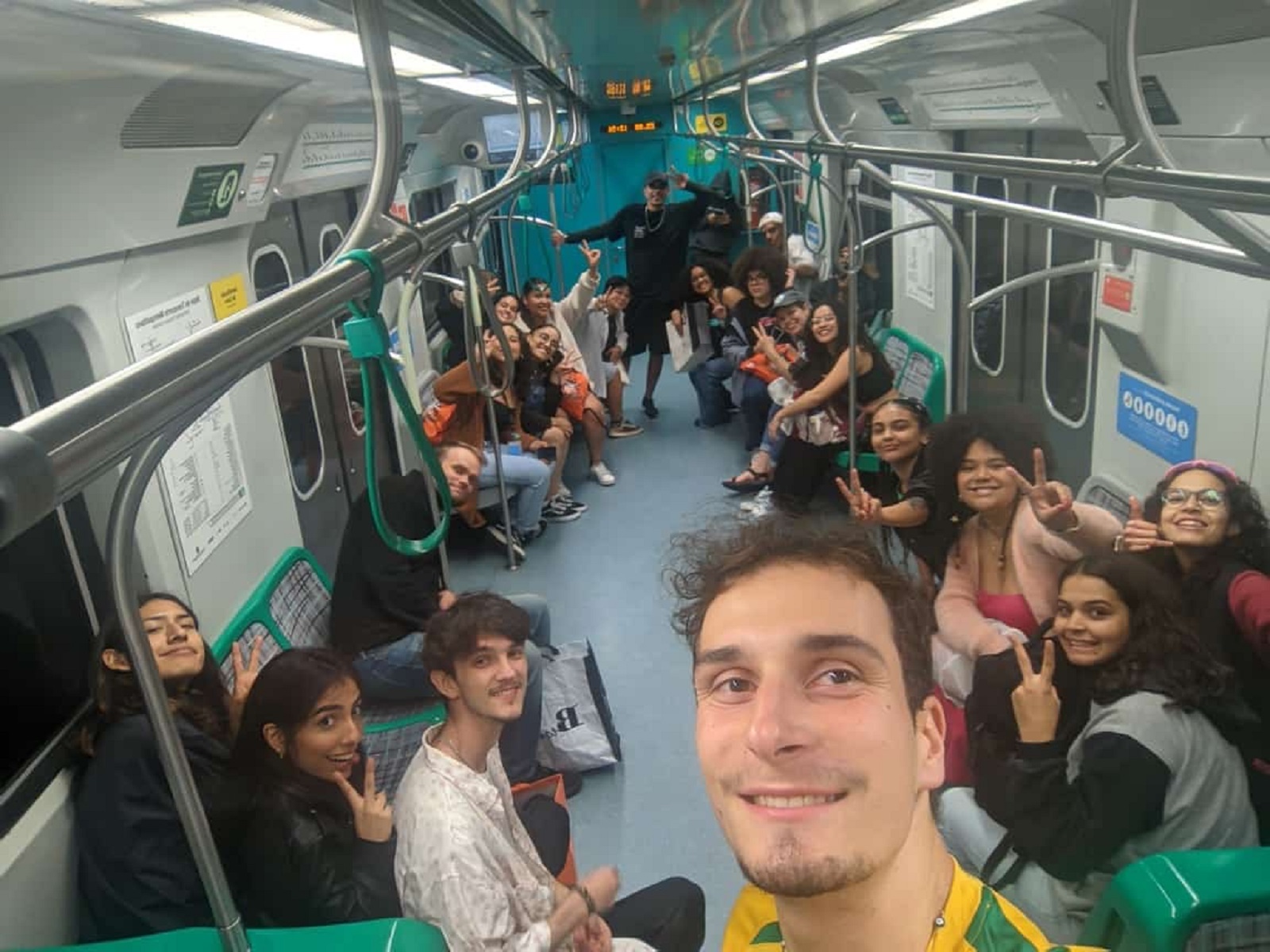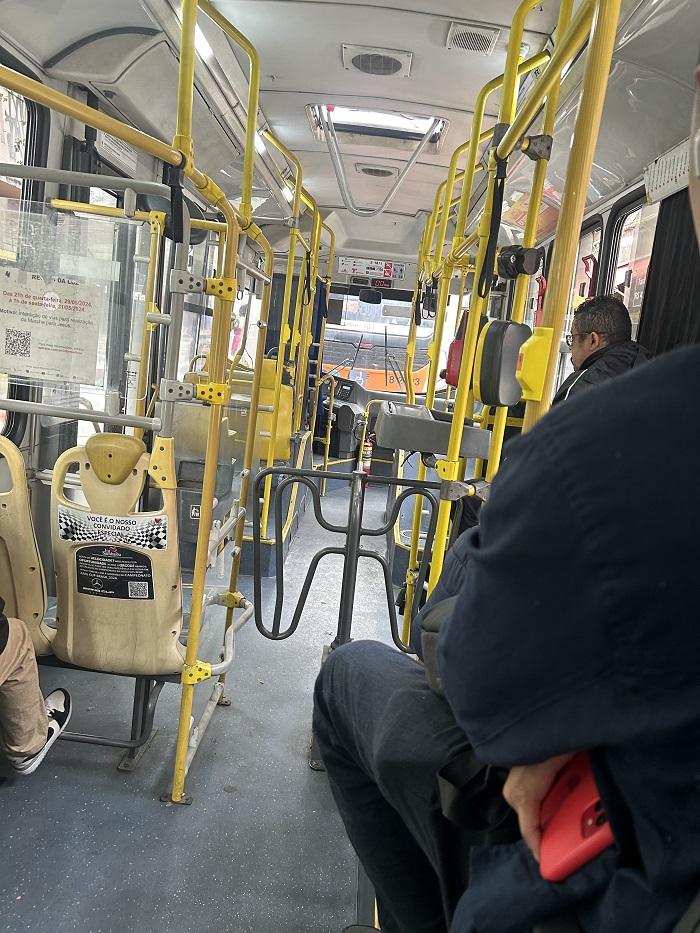Written by Martha Denton, (University of Minnesota), Student Correspondent for CET Brazil, (USP track), Fall 2024
If you look closely at the city buses in São Paulo, you’ll see a small rectangle with the words: “Transporte: Um Direito do Cidadão; Um Dever do Estado.” In English, this translates to “Transit: A Right of the Citizen; A Duty of the State.” Public transit is a big deal in Brazil, it’s even enshrined as a right in the Brazilian federal constitution.
Growing up in car-centric North Dakota, like most Americans, I didn’t have access to reliable public transit. But in São Paulo, it’s possible to get basically anywhere you need to go without ever getting in a car. Yes, taxis and rideshare services like Uber are abundant and relatively inexpensive. So, if you’re out late or going somewhere in a group, that’s definitely an option. But I would argue against making Uber your default way of getting around. With a little patience and preparation, public transit can be a more sustainable, cost-effective, and engaging way to explore the city.
Why take transit in São Paulo?
Since I live in the neighborhood Perdizes, but study at the University of São Paulo (USP) in the neighborhood Butantã, my daily commute to class takes 50-60 minutes across two different buses, in each direction. Initially, this felt pretty tedious. But I’ve come to enjoy the time to study, listen to music, or just sit and enjoy the view. In a city with an area of 1,523 km², long commutes are common.
My friend Thaisa takes a bus, then two metro lines, then another bus just to get to campus. And my classmate Fernando told me it takes almost 3 hours to get to our urban geography class. This post is mostly about the bus system since that’s what I use more regularly. But, São Paulo also has the largest urban rail system in Latin America. This is especially useful for getting between the five zones of the city.
Here’s a list of seven reasons to take public transit during your time in São Paulo:
- Sustainability: Riding in a car uses significantly more fossil fuels than sharing your ride with other passengers on the bus or metro. The world, especially the Global South, is already experiencing the extreme effects of human-caused climate change. I was yet again reminded of this reality as the extreme wildfires in the state of São Paulo have severely affected the city’s air quality over the past week.
- Budget: The standard bus fare is only R$ 4.40 (~USD $0.78) and metro tickets are R$ 5.00 (~USD $0.89). Once you get your Bilhete Único de Estudante (student transit pass), that number gets cut in half (and transfers are free).
- Speed: You might be used to cars being 2-5x faster than taking the bus in many American cities. But since practically every street has a bus lane and the metro operates underground, you’ll often find it takes about the same time, or even less. Enjoy the feeling of zipping past a traffic jam in your $500,000 publicly-operated chariot.
- Community: Staying in a car isolates you from the city around you and the people that inhabit it. Transit is the most democratic form of transportation. It allows you to interact with Paulistanos from all walks of life getting to work, school, or running errands.
- Reduce congestion: With a population of over 22 million people, making it the largest metropolitan area in the Western and Southern Hemispheres, there isn’t enough space for everyone to drive in São Paulo. Having lots of personal cars on the road clogs streets. This leads to longer travel times, more air pollution, and generally a less pleasant urban atmosphere. Buses and trains are the most space efficient forms of transportation, essential in a dense urban environment.
- Sightseeing: Take advantage of the enormous bus windows to admire your surroundings on the way to your destination. I especially enjoy the view of the Pinheiros River on my way to campus.
- Do as Brazilians do! Every day, over 7 million people in São Paulo commute using public transit. Even if you’re taking classes at PUC-SP right near your apartment, take advantage of the bus or metro to get to museums, restaurants, theaters and other attractions. Riding with a group of friends can be an especially fun way to get around!

That being said, being a transit rider is not always glamorous. You might find yourself sardined into a packed bus, watching the minutes drag by as you wait for a delayed bus to arrive, or sprinting to get through the metro doors before they close. But don’t be discouraged! Just remember what you’re doing for the planet, your wallet, and your cultural knowledge.
How is transit different from the U.S.?
Navigating an unfamiliar transit system can be daunting, so here are some key differences from what you may be used to in the U.S. to get you started:
- While in the U.S. there’s typically one bus operator who drives the bus and also collects fares, in São Paulo that job is usually split between the driver (motorista) and the fare collector (cobrador).
- Buses in São Paulo have a turnstile (catraca) that you pass through once you’ve paid your fare. So you enter at the front, pay your fare at the turnstile in the middle, then exit out the back. Turnstiles are very common in Brazil, you pass through them in stores, administrative offices, event spaces, and school buildings.

- Since the city has 1,337 bus routes, the routes aren’t labeled with a simple “1, 2, 3” etc. For example, I regularly take the 175P-10 and the 701U-10. Make sure you know the exact bus number you’re looking for. You can also take a look at the screen above the windshield, which flashes the bus’s final destination to help orient you.
Transit Inequality in São Paulo
Since the guiding principle of CET Brazil is social justice, it’s important to note that while access to transit is considered a right in Brazil, in practice, it’s not equally accessible to all. Paulistanos who live in the peripheries of the city, sometimes in informal settlements known as favelas, often don’t have access to metro lines or high frequency buses.
Metro lines are often planned based on how much revenue can be generated, rather than how many people can be served. And the government’s decision to privatize certain subway lines (such as lines 4, 5, and 6) has made the quality of services plummet. Extreme socioeconomic inequality is present in every aspect of life in São Paulo.
While the majority of residents rely on public transit, walking, and biking, it’s also the city with the largest number of private helicopters. Helicopters are so ubiquitous in the city that after a while you might stop hearing them flying above. Such contradictions are central to São Paulo. Be prepared to consider similar questions in your coursework and in your day-to-day life.
How else can I get around?
- Walking: For shorter distances, walking is often a great option. But, you should be prepared to walk some steep hills in Perdizes. What looks like a simple 10-minute walk on a map might actually be a 20-minute hike that leaves you out of breath. While walking around, always keep your belongings close and don’t have your cellphone out in the open.
- Biking: Another option is renting a bike. Most neighborhoods have stations where you can rent bikes by the minute using an app. One highlight of my time here has been renting bikes with two of the Brazilian roommates. We biked the Minhocão, which translates to “big worm.” It’s an elevated road that’s widely considered to be an urban planning disaster. The upside is it’s closed to cars on weekends. So, pedestrians and bicyclists can take in the beautiful murals on the buildings that line the road. I’m also excited to rent a bike in Parque Ibirapuera, an enormous urban park near the center of the city.

Trips and tricks
São Paulo is a city full of surprises. Every day I learn something new about the geography of the city and how to navigate it. Here are some tips I’ve come up with (many of which I learned the hard way) to help you get to your destination using public transit:
- Navigation: Use apps like Google Maps or Moovit to chart your journey. They’ll tell you where to get on, the number of the bus, when it’ll arrive, and how long your journey will take. You can double-check the route number by looking at the sign posted at the stop. Luckily, in São Paulo bus stops typically have pretty clear information. This was unlike Rio, where I once waited at a bus stop that was just a little drawing of a bus nailed to a tree!
- Boarding: When the bus approaches, put your arm out to make sure the driver knows you intend to get on. Many bus routes pass through the same stops, so they won’t necessarily stop just because there are people waiting.
- Fares: Fare collectors are often short on change, so if you pay with a bill larger than a R$ 10 you may get a displeased look. They may also not be able to accept the bill. Try to have small bills and coins available if you don’t yet have a bus pass to tap.
- Backpacks: Wear your backpack in front of you. This makes sure you don’t bump into other riders or risk having belongings stolen.
- Turnstiles: Be strategic about passing the turnstile. If you need to get off soon and the bus is packed, you can pay the fare collector and not pass the turnstile. That way, you can exit at the front of the bus without pushing through a crowd to exit at the back.
- Plan ahead: If you need to be somewhere at a specific time, always add an extra 10-20 minutes to your trip time to account for delays, especially when it’s raining.
- Vocabulary: One important difference from English is that in Portuguese, trânsito (or tráfego) means traffic, while transporte means transit. And if you’re a Spanish speaker, make sure you don’t say tráfico to refer to traffic. In Portuguese, people only used in the context of drug/illegal trafficking! Below are some key vocabulary to help you out if you need to ask a question:
- Bus: o ônibus
- Stop: a parada
- Station: a estação
- To get off: descer
- To get on: embarcar
- Door: a porta
- Fare: a tarifa
- Change ($): troco
- Domingão Tarifa Zero: The bus is free on Sundays (which sounds like it was mostly a mayoral re-election stunt, and may not be here to stay). But definitely take advantage of this if you can. For example, by taking the bus to Avenida Paulista (the major street through the financial district) which is closed to cars on Sundays.

I hope you find this post informative as you prepare for your time in São Paulo. If you’re nervous about taking the bus or metro alone, ask a friend or roommate to go with you until you get the hang of it. Pretty soon, you’ll be zipping around the city like a pro.
Source link
All Materials on this website/blog are only for Learning & Educational purposes. It is strictly recommended to buy the products from the original owner/publisher of these products. Our intention is not to infringe any copyright policy. If you are the copyright holder of any of the content uploaded on this site and don’t want it to be here. Instead of taking any other action, please contact us. Your complaint would be honored, and the highlighted content will be removed instantly.
